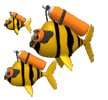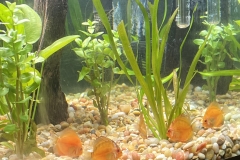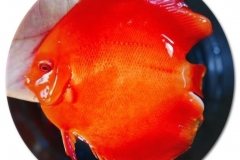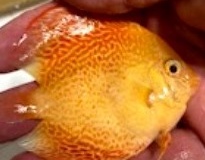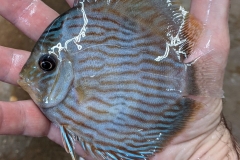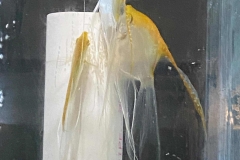The Siam Yellow Master is a recently developed Pigeon Blood derived strains. It was developed around 2004 in Thailand. It started with a Golden Sunrise Discus, which is actually a hybrid of a Pigeon Blood Discus that was a mostly yellow variant and a wild caught Golden Discus. Through Selective Breeding, it was developed to have a much deeper Yellow coloration. They have little to no red in the fins. The ones we sell today have very little to no peppering and when they do it is mostly temporary/transient peppering that will go away when the fish are not stressed. As juveniles, Siam Yellow Masters usually do not show their full coloration and are a pale yellow. As they mature, the yellow coloration will slowly deepen until they are a very deep yellow as mature adults. Siam Yellow Master will usually have a perfect round body even as juveniles.
Pigeon Blood Discus were originally developed from a mutation found in a Red Turquoise Discus in 1989. Kitti Phanaithi, a breeder of Discus since 1970 in Thailand, saw a Discus in a friends tank that had a very yellow and golden sheen in the coloration. It also had considerable black coloration in the fins and a little on the body. It had extremely bright yellow eyes. Kitti recognized that this was probably a naturally occurring mutation and purchased the Discus for 3000.00 USD. He then selectively crossbred it with other Red Turquoise Discus to develop the Pigeon Blood strain. Kitti first showed the Discus to the world at the 1991 Aquarama in Singapore.
Most of the brightly colored yellow, gold, orange and light red Discus are Pigeon Blood derived strains. As mentioned previously, some of these are the Red Melon, Fire Dragon, Siam Yellow Master, Golden Sunrise. Recently, more strains of different coloration such as light blues and white (Snow White Discus are not derived from Pigeon Blood) have been developed. About 10 years ago, Pigeon Blood Discus with bright red eyes were developed. At first, most of the Pigeon Blood derived Discus still had the black “peppering” on most of the fins and some of the body. Over the last 20 years, since the Pigeon Blood was first developed, highly selective breeding has been successful in getting rid of most of the black peppering. With that said, many of the pigeon blood strains will show a little black peppering. The black peppering will increase dramatically when these Discus are stressed. The black peppering will come on very fast once the fish is under stress. Once the stress is gone, the peppering will slowly decrease, but this can take months. Pigeon Blood derived Discus do not develop Stress Bars when under stress like most other Discus. Instead, the peppering is the main sign of stress.
Other than coloration, Pigeon Blood derived Discus are exactly like any other Discus and require the same conditions.
